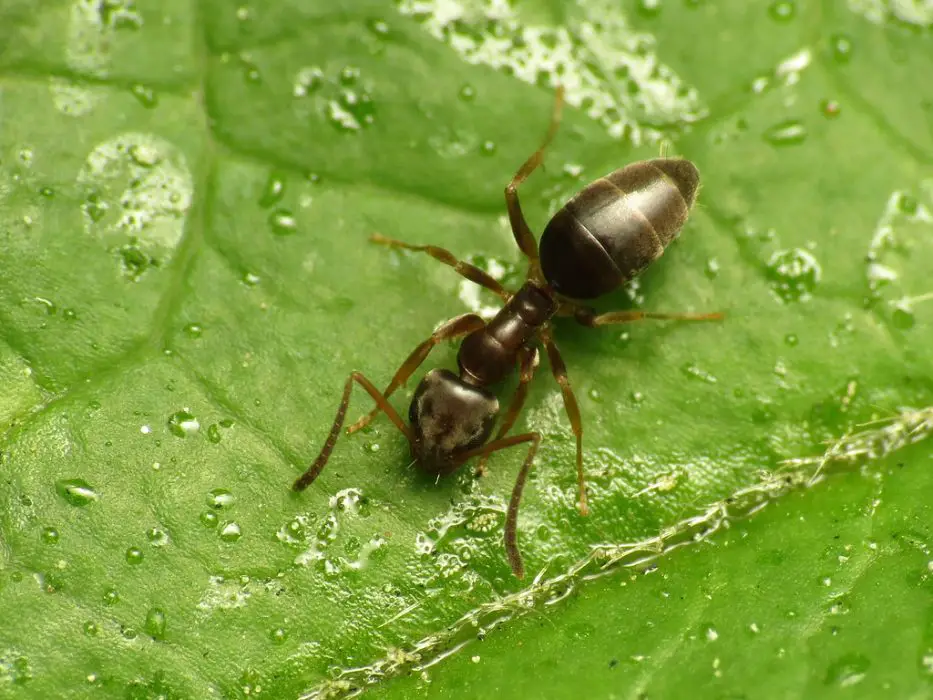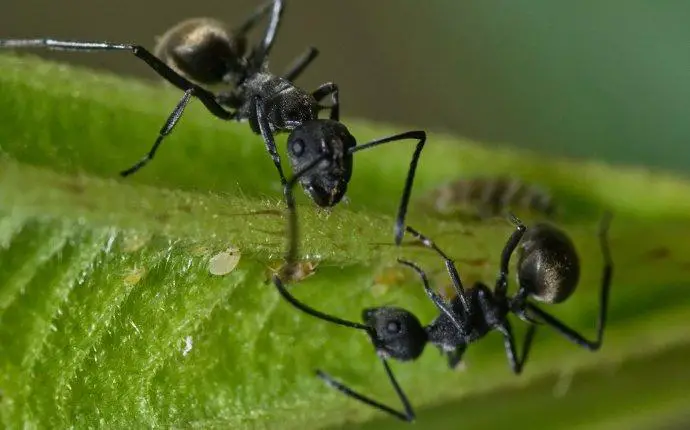Visualize this: you’re calmly enjoying your morning coffee, lost in deep thoughts when suddenly, a procession of ants emerges on your kitchen countertop. But wait, these aren’t your average uninvited guests; these are the odorous house ants, the aromatic explorers of the insect world, armed with a scent that could rival any fragrance.
While other ants might settle for a simple meal, these fragrant foragers have loftier goals. They’re not merely looking for a snack; they’re on a mission to uncover the secrets of your home, navigating its nooks and crannies with unmatched precision.
It’s as though you have a team of curious detectives investigating every corner of your living space, each step leaving behind a distinct, albeit peculiar, trail of scent.
So, prepare for a sensory adventure, follow their aromatic path, and join us as we delve into the world of these inquisitive home invaders
What Do Odorous House Ants Look Like?
Odorous house ants, scientifically known as Tapinoma sessile, are relatively small ants with distinct characteristics:
- Color: They are typically brown to black in color.
- Size: Odorous house ants are relatively small, with adult worker ants ranging from 2.4 to 3.3 millimeters in length.
- Body Segments: They have the standard ant body structure, consisting of three main segments: the head, thorax, and abdomen. There is a noticeable constriction between the thorax and abdomen.
- Antennae: Their antennae have 12 segments and lack a distinct club at the tip. These antennae are quite flexible and can move in various directions.
These characteristics can help you identify odorous house ants when you encounter them.
Odorous House Ant Queen
The odorous house ant queen is the central figure in an odorous house ant colony.
Here are some characteristics of the odorous house ant queen:
- Size: The queen is typically larger than the worker ants in the colony. She can measure around 4 to 4.5 millimeters in length.
- Role: The primary role of the queen is reproduction. She lays eggs that give rise to the colony’s worker ants and, eventually, new queens and male ants during specific stages of the ant life cycle.
- Lifespan: Odorous house ant queens have relatively long lifespans compared to worker ants. They can live for several years, contributing to the colony’s longevity.
- Egg Laying: The queen continuously lays eggs in the colony, often at a prolific rate. Her ability to produce a large number of offspring is crucial for the colony’s growth and survival.
- Protection: The queen is typically well-protected within the nest. Worker ants tend to her needs, ensuring she is safe and provided with nourishment.
Do Odorous House Ants Have Wings?
Odorous house ants, although they do have winged individuals within the colony known as alates, typically do not have wings themselves. Instead, these winged ants, or alates, are reproductive individuals produced for a specific purpose: mating and starting new colonies.
When conditions are right, such as during a nuptial flight, alates emerge from the colony with the sole purpose of reproducing. Subsequently, once mating is complete, the males die, and the mated females shed their wings.
As a result, these wingless, mated females then become the queens of new colonies, where they begin laying eggs and establishing a fresh generation of odorous house ants.
Odorous House Ant Nest

Odorous house ants are known for creating nests in a variety of locations. These nests are often found in concealed or protected areas.
Here are some common places where you might find odorous house ant nests:
- Indoors: Odorous house ants are notorious for nesting indoors, often in wall voids, insulation, under floors, or in other hidden spaces. They are attracted to warmth and moisture, which can lead them to seek shelter inside homes.
- Outdoors: These ants can establish nests outdoors as well. They often choose locations such as under rocks, in rotting logs, in mulch, and beneath leaf litter. They may also nest in soil or in the shallow depressions of the ground.
- Near Moisture Sources: Odorous house ants are drawn to moisture, so you may find their nests close to water sources like leaky pipes, faucets, or damp areas in basements or crawl spaces.
- Around Food Sources: They tend to build nests near their foraging areas, which could be around food sources in kitchens, pantries, or outdoor trash bins.
- In Wall Voids: These ants can construct nests within wall voids, making them difficult to detect until they start foraging inside the house.
What Do Odorous House Ants Eat?
Odorous house ants have a diverse diet, which contributes to their adaptability and ability to thrive in various environments.
Here’s what odorous house ants typically eat:
- Sugary Substances: These ants are especially fond of sugary substances. They feed on nectar from flowers, honeydew produced by aphids and other sap-sucking insects, and sweet fruit juices.
- Scavenged Food: These ants are opportunistic scavengers and will forage for food scraps left behind by humans. This can include sugary snacks, spilled juice, or crumbs from food.
- Protein: They also require protein for their diet. They hunt for small insects like flies, caterpillars, and other arthropods to supplement their protein intake.
- Fruits: When fruits are available, odorous house ants may feed on the sweet juices of ripe fruits.
- Seeds and Plant Material: On occasion, these ants may collect seeds and plant material, although this is less common compared to their preference for sugary and protein-rich foods.
What Do Odorous House Ants Smell Like?
Odorous house ants, as their name suggests, emit a distinctive odor when they are crushed or threatened. Specifically, this odor is often described as smelling like rotten coconut, blue cheese, or sometimes even a sweet, fruity scent.
Moreover, the odor can vary slightly among individuals and colonies but is generally recognizable as pungent and unpleasant.
Notably, this odor serves as a defense mechanism used by odorous house ants to deter predators and protect their colony. Consequently, it is one of the key characteristics that help people identify these ants when they encounter them.
Odorous House Ants Bite
Yes, odorous house ants are capable of biting; however, they are not typically aggressive towards humans. Their bites are considered relatively mild, often described as a slight pinch or stinging feeling.
Moreover, the pain from their bites is generally short-lived, causing only minor discomfort. Additionally, allergic reactions or severe responses to odorous house ant bites are extremely rare. These ants are not known for delivering painful or harmful bites; instead, their primary defense mechanism is the unpleasant odor they emit when threatened or crushed.
Consequently, while odorous house ant bites may be momentarily unpleasant, they are generally not a significant cause for concern and do not pose serious health risks to most individuals.
How To Get Rid Of Odorous House Ants
To effectively get rid of odorous house ants, you can follow these steps:
- Identify the Ant Trails: First, locate the ant trails and entry points into your home. Follow their path to determine where they are coming from and going.
- Maintain Cleanliness: Keep your home clean and free of food debris. Clean up spills, crumbs, and food residues promptly. Store food in airtight containers, and keep pet food dishes clean.
- Seal Entry Points: Seal cracks, gaps, and openings in doors, windows, and walls where ants can enter your home. Use caulk or weatherstripping to seal these entry points.
- Natural Deterrents: Use natural repellents to disrupt ant trails. Common options include vinegar, lemon juice, or essential oils like peppermint. These scents can deter ants from entering your home.
- Ant Baits: Consider using ant baits specifically designed for odorous house ants. These baits are carried back to the colony by worker ants and can effectively eliminate the entire colony, including the queen.
- Professional Help: For severe infestations or if your efforts do not yield results, it may be necessary to consult a pest control expert. They can assess the situation and use specialized treatments to eliminate the ant colony.
- Maintain Outdoor Areas: Keep outdoor areas clean as well. Ensure that trash bins are sealed, and minimize moisture sources near your home.
- Trim Vegetation: Trim branches and vegetation that touch or overhang your home, as these can serve as bridges for ants to access your house.
- Regular Inspection: Periodically inspect your home for any signs of ant activity, even after you have eliminated the initial infestation. Early detection can help prevent future
Conclusion
Odorous house ants may be small, but their adaptability and persistence can make them a nuisance in your home. Identifying their presence, maintaining cleanliness, and using effective ant baits are crucial steps in controlling and preventing infestations.
While their bites are generally mild, the distinctive odor they emit when threatened can be quite unpleasant. By following these measures and seeking professional help when needed, you can effectively manage odorous household issues and maintain a pest-free living environment.



